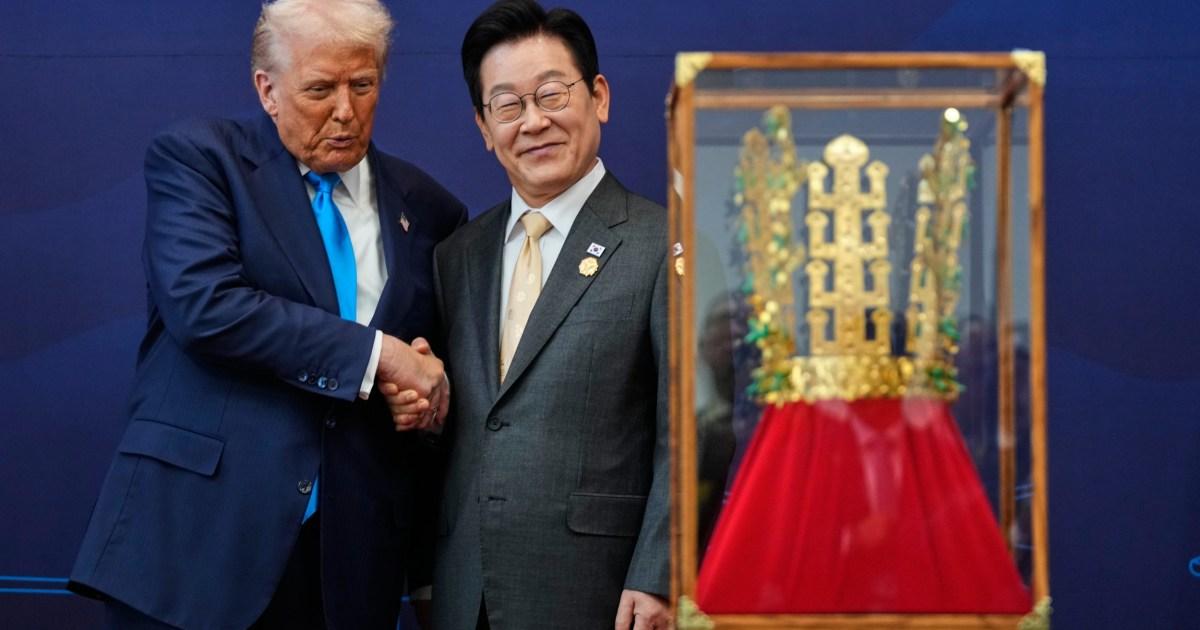U.S. President Donald Trump was welcomed in South Korea on March 4, 2024, with a symbolic gesture: a replica gold crown and the nation’s highest honor, the Grand Order of Mugunghwa. This award, presented by South Korean President Lee Jae Myung, acknowledges Trump’s perceived role as a peacemaker on the Korean peninsula during his ongoing visit to Asia, which also included stops in Japan and Malaysia.
Upon receiving the crown, Trump expressed a desire to wear it immediately, highlighting the significance of the occasion. The replica resembles the original Cheonmachong crown, discovered in a tomb in Gyeongju, notable for its ornate gold prongs and leaf shapes.
Protests Mark Trump’s Visit
Trump’s arrival coincided with a series of protests across the United States organized under the banner ‘No Kings,’ which criticized his administration’s policies on immigration, education, and security. Organizers reported that around 2,700 events took place in all 50 states, reflecting widespread discontent with the current administration. This mobilization follows a similar protest in June 2023, illustrating ongoing tensions between the government and segments of the public.
Demonstrators chanted slogans and displayed signs voicing their opposition to federal immigration raids, the deployment of military troops, and other contentious issues. While protesters gathered in the U.S., North Korea conducted successful cruise missile tests, further complicating the geopolitical landscape.
Seeking Dialogue with North Korea
During his visit, Trump reiterated his interest in meeting North Korean leader Kim Jong Un, although he acknowledged the challenges in arranging such a meeting. “I know Kim Jong Un very well. We get along very well,” Trump stated before his meeting with President Lee. “We really weren’t able to work out timing.”
Earlier aboard Air Force One while traveling from Japan to South Korea, Trump appeared to downplay the importance of North Korea’s recent missile tests, stating, “He’s been launching missiles for decades, right?” Meanwhile, South Korea’s Joint Chiefs of Staff confirmed that both Seoul and Washington were closely monitoring the situation, maintaining readiness for a coordinated response to any North Korean provocations.
The latest missile tests by North Korea came shortly after short-range ballistic missile launches, with claims that these tests involved a new hypersonic system aimed at enhancing its nuclear deterrent capabilities. Despite these developments, North Korea has not responded to Trump’s overtures for dialogue, having largely withdrawn from negotiations since the collapse of discussions in 2019 regarding U.S.-led sanctions.
Experts suggest that North Korea is unlikely to engage in talks unless substantial concessions, such as significant sanctions relief, are offered by the United States. Nevertheless, some analysts believe that Trump’s continued attempts at engagement may compel Pyongyang to reconsider its stance.
The juxtaposition of Trump’s warm reception in South Korea and the intense protests back home underscores the complex dynamics of his presidency, particularly in the context of international relations and domestic unrest. As the situation evolves, both the U.S. and South Korea remain vigilant in addressing the challenges posed by North Korea.







